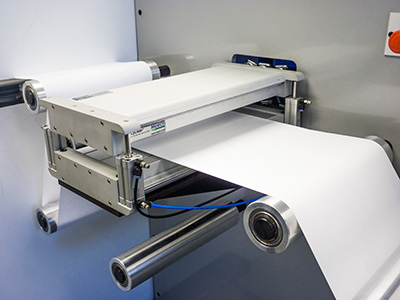Static Control: Crucial to Fluid Converting Processes
- Published: March 16, 2020
By Matt Fyffe, Vice President and General Manager at Meech International
The static charge often found on converting lines is an ongoing problem for a variety of industries. Paper, foil, plastic and various other materials can all fall victim to the effects of static charges – the results of which can be detrimental to production and health and safety.
Static is typically the result of an imbalance of electrical charges on a substrate, which is generated through the friction or separation between two objects – a web unwinding from a roll to be formed for labeling or packaging, for example. When not controlled, static can attract dust, dirt and other assorted particles, causing machinery to become blocked or damaged and ultimately compromise the quality of the end product. This includes print being out of register, small holes appearing in extruded film, and the final products appearing distorted.
In industries such as food and drink, where optimum product appearance is paramount, the competition on supermarket shelves is fiercer than ever. Engaging packaging and labels are designed to catch the eye of the consumer – any faded or inferior products are less likely to grab attention, so aesthetics are vital.
For companies in the healthcare and pharmaceutical sectors, the need for quality control is essential, as any products that are found to contain foreign bodies or contaminants within the packaging will be rejected outright.
Regardless of the sector, contaminated packaging and labeling can lead to excessive rework levels, as well as increased wastage, downtime and running costs. As convertors are faced with the pressure to deliver faster against increasingly tight deadlines, in order to remain competitive, the possibility of static charges being generated is further increased – fast running machinery generates static on the web surface and, by generating heat, can also increase static levels in the ambient air.
Static shocks can also lead to injury for workers in the vicinity. Though an initial static shock may subside quickly, the involuntary reaction of a worker may cause them to interact physically and suddenly with equipment or another member of staff.
Fortunately, technology is available that can counter the threat static poses.

Combatting Static
Static control measures should be carefully considered by converters dealing with manufacturing processes to ensure consistent quality. Containing ionization technology, static control solutions work to neutralize charges and, in tandem with a web cleaner, prevent the attraction of dust and dirt onto the web’s surface. The technology employs high voltage AC or ‘pulsed’ DC to produce ionized air which creates a high-energy cloud of positive and negative ions to neutralize static electricity present on production equipment. This ensures that many potentially costly production problems are avoided.
Pulsed DC ionizing bars can provide short, medium and long-distance static elimination on a wide range of materials at each stage of the converting process. This highly regarded technology also benefits from today’s industry 4.0 technology – an increasingly common concept that envisions significantly higher productivity and efficiency through people and machinery working together harmoniously.
Monitoring and adjusting the performance of connected static control equipment through a mobile phone, tablet or remote desktop, tracks equipment performance and allows the user to easily assess the ionizing performance. It can achieve this through LAN or WAN networks, which allow access to performance information at any place or time, enabling operating settings to be easily amended to ensure maximum productivity and quality of output.
But static control alone may not be enough to remove all traces of contamination. A web cleaner is a vital partner in ensuring any converted materials are in pristine condition.
Web Cleaners
Though static control provides a highly effective solution, combining it with a web cleaner allows for optimum web and converting performance. Contact and non-contact web cleaning systems are available – deciding on the most practical system depends on the web materials being processed, the application, the flexibility required by the converting line and the speed of the web.
Contact cleaners, as the name suggests, make contact with the web and break the boundary layer. Some such systems incorporate twin elastomer rollers, which are in full contact with the entire width of the web and physically lift debris from the web’s surface. They are generally better suited to slower moving webs and more robust materials. Non-contact systems use blow-and-vacuum technology either side of the web, stripping the boundary layer of contaminants which are captured and subsequently removed. The use of air prevents issues surrounding marks or damage to sensitive webs.
Due to its impact on web and converting machinery performance, static’s elimination should be a fundamental part of the quality control measures adopted by any converter. Selain itu permainan yang disediakan oleh Situs Judi dadu online Terpercaya ini juga mempunyai perbedaan dengan permainan live casino lainnya, Pada permainan dadu ini memiliki perhitungan pembayaran yang besar jika anda berhasil menebak dengan benar pada taruhan yang anda pilih. Tentunya pada permainan dadu online tersedia beberapa jenis taruhan yang bisa dipilih oleh bettor. Pada penjelasan kali ini kami akan memberikan informasi mengenai jenis taruhan yan tersedia, Combining automated static control and a web cleaner can allow for the most pristine of webs, guaranteeing consistent end-product quality, reducing the need for maintenance and ensuring high levels of health and safety are observed.
About the Author
Matt Fyffe is the vice president and general manager for Meech International. He heads up the five principal sector solutions for Meech in the USA; static control, web cleaning, energy saving compressed air equipment, jetstream air knife systems and the IonRinse™ ionised air rinsing and air cleaning systems.











